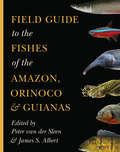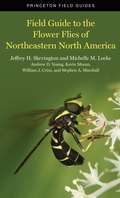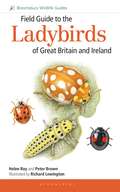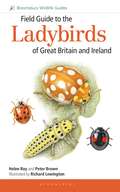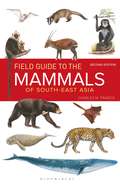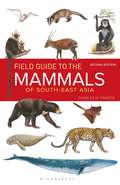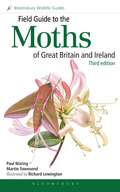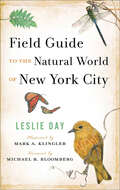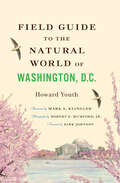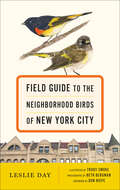- Table View
- List View
Field Guide to the Caterpillars of Great Britain and Ireland (Field Guides)
by Phil Sterling Barry Henwood'A much-needed guide – you can't truly understand a moth or a butterfly without first getting to know the caterpillar.' – Nick BakerThis beautifully illustrated field guide covers caterpillars of the moth and butterfly species that are most likely to be encountered in the British Isles. The comprehensive introduction covers how to study caterpillars and provides a window into their diverse natural histories, while the species accounts cover status, field characters, similar species, habitat, foodplant and field notes, and are accompanied with up-to-date distribution maps.
Field Guide to the Caterpillars of Great Britain and Ireland (PDF)
by Phil Sterling Barry Henwood'A much-needed guide – you can't truly understand a moth or a butterfly without first getting to know the caterpillar.' – Nick BakerThis beautifully illustrated field guide covers caterpillars of the moth and butterfly species that are most likely to be encountered in the British Isles. The comprehensive introduction covers how to study caterpillars and provides a window into their diverse natural histories, while the species accounts cover status, field characters, similar species, habitat, foodplant and field notes, and are accompanied with up-to-date distribution maps.
Field Guide to the Dragonflies and Damselflies of Great Britain and Ireland (Field Guides)
by Steve Brooks Steve ChamAll Great Britain and Ireland's resident and migrant dragonfly and damselfly species fully described and illustrated. Fully updated, revised and redesigned, this 2014 edition features full descriptions, ecological notes and distribution maps, as well as a general introduction and regional guide to the best places to watch dragonflies. The 2002 edition was shortlisted for the BP Natural World Book Prize.
Field Guide to the Dragonflies and Damselflies of Great Britain and Ireland (Field Guides)
by Steve Brooks Steve ChamAll Great Britain and Ireland's resident and migrant dragonfly and damselfly species fully described and illustrated. Fully updated, revised and redesigned, this 2014 edition features full descriptions, ecological notes and distribution maps, as well as a general introduction and regional guide to the best places to watch dragonflies. The 2002 edition was shortlisted for the BP Natural World Book Prize.
Field Guide to the Dragonflies of Britain and Europe: 2nd edition (Field Guides)
by K-D Dijkstra Asmus SchröterThe first edition of the Field Guide to the Dragonflies of Britain and Europe was a ground-breaking identification guide that led to an increase in Odonata recording across Europe. The second edition includes fully revised regional guides and identification texts, updated distribution maps and conservation statuses, illustrated accounts for five species that have been discovered in the region since the first edition, updated checklists and taxonomy, new photographs throughout, as well as an introduction to larvae identification. Each species is lavishly illustrated with artworks of males, females and variations, as well as close-ups of important characters.
Field Guide to the Dragonflies of Britain and Europe: 2nd edition (Field Guides)
by K-D Dijkstra Asmus SchröterThe first edition of the Field Guide to the Dragonflies of Britain and Europe was a ground-breaking identification guide that led to an increase in Odonata recording across Europe. The second edition includes fully revised regional guides and identification texts, updated distribution maps and conservation statuses, illustrated accounts for five species that have been discovered in the region since the first edition, updated checklists and taxonomy, new photographs throughout, as well as an introduction to larvae identification. Each species is lavishly illustrated with artworks of males, females and variations, as well as close-ups of important characters.
Field Guide to the Fishes of the Amazon, Orinoco, and Guianas
by Peter van der Sleen James S. AlbertThe Amazon and Orinoco basins in northern South America are home to the highest concentration of freshwater fish species on earth, with more than 3,000 species allotted to 564 genera. Amazonian fishes include piranhas, electric eels, freshwater stingrays, a myriad of beautiful small-bodied tetras and catfishes, and the largest scaled freshwater fish in the world, the pirarucu. Field Guide to the Fishes of the Amazon, Orinoco, and Guianas provides descriptions and identification keys for all the known genera of fishes that inhabit Greater Amazonia, a vast and still mostly remote region of tropical rainforests, seasonally flooded savannas, and meandering lowland rivers.The guide’s contributors include more than fifty expert scientists. They summarize the current state of knowledge on the taxonomy, species richness, and ecology of these fish groups, and provide references to relevant literature for species-level identifications. This richly illustrated guide contains 700 detailed drawings, 190 color photos, and 500 distribution maps, which cover all genera. An extensive and illustrated glossary helps readers with the identification keys.The first complete overview of the fish diversity in the Amazon, Orinoco, and Guianas, this comprehensive guide is essential for anyone interested in the freshwater life inhabiting this part of the world.First complete overview of the fish diversity in the Amazon and Orinoco basinsContributors include more than fifty expertsIdentification keys and distribution maps for all genera190 stunning color photos 700 detailed line drawingsExtensive and illustrated glossary
Field Guide to the Fishes of the Amazon, Orinoco, and Guianas
by Peter van der Sleen James S. AlbertThe Amazon and Orinoco basins in northern South America are home to the highest concentration of freshwater fish species on earth, with more than 3,000 species allotted to 564 genera. Amazonian fishes include piranhas, electric eels, freshwater stingrays, a myriad of beautiful small-bodied tetras and catfishes, and the largest scaled freshwater fish in the world, the pirarucu. Field Guide to the Fishes of the Amazon, Orinoco, and Guianas provides descriptions and identification keys for all the known genera of fishes that inhabit Greater Amazonia, a vast and still mostly remote region of tropical rainforests, seasonally flooded savannas, and meandering lowland rivers.The guide’s contributors include more than fifty expert scientists. They summarize the current state of knowledge on the taxonomy, species richness, and ecology of these fish groups, and provide references to relevant literature for species-level identifications. This richly illustrated guide contains 700 detailed drawings, 190 color photos, and 500 distribution maps, which cover all genera. An extensive and illustrated glossary helps readers with the identification keys.The first complete overview of the fish diversity in the Amazon, Orinoco, and Guianas, this comprehensive guide is essential for anyone interested in the freshwater life inhabiting this part of the world.First complete overview of the fish diversity in the Amazon and Orinoco basinsContributors include more than fifty expertsIdentification keys and distribution maps for all genera190 stunning color photos 700 detailed line drawingsExtensive and illustrated glossary
Field Guide to the Flower Flies of Northeastern North America (Princeton Field Guides #134)
by Jeffrey H Skevington Michelle M. Locke Andrew D. Young Kevin Moran William J Crins Stephen A. MarshallA groundbreaking guide to flower flies in North America This is the first comprehensive field guide to the flower flies (also known as hover flies) of northeastern North America. Flower flies are, along with bees, our most important pollinators. Found in a varied range of habitats, from backyard gardens to aquatic ecosystems, these flies are often overlooked because many of their species mimic bees or wasps. Despite this, many species are distinctive and even subtly differentiated species can be accurately identified. This handy and informative guide teaches you how.With more than 3,000 color photographs and 400 maps, this guide covers all 416 species of flower flies that occur north of Tennessee and east of the Dakotas, including the high Arctic and Greenland. Each species account provides information on size, identification, abundance, and flight time, along with notes on behavior, classification, hybridization, habitats, larvae, and more.Summarizing the current scientific understanding of our flower fly fauna, this is an indispensable resource for anyone, amateur naturalist or scientist, interested in discovering the beauty of these insects.· 3000+ color photos (field and museum shots)· Multiple images per species, with arrows highlighting key field marks· Grayscale images showing the actual size of the insect· Range maps for each species· Information on size, identification features, abundance, flight times, and more
Field Guide to the Flower Flies of Northeastern North America (Princeton Field Guides #134)
by Jeffrey H Skevington Michelle M. Locke Andrew D. Young Kevin Moran William J Crins Stephen A. MarshallA groundbreaking guide to flower flies in North America This is the first comprehensive field guide to the flower flies (also known as hover flies) of northeastern North America. Flower flies are, along with bees, our most important pollinators. Found in a varied range of habitats, from backyard gardens to aquatic ecosystems, these flies are often overlooked because many of their species mimic bees or wasps. Despite this, many species are distinctive and even subtly differentiated species can be accurately identified. This handy and informative guide teaches you how.With more than 3,000 color photographs and 400 maps, this guide covers all 416 species of flower flies that occur north of Tennessee and east of the Dakotas, including the high Arctic and Greenland. Each species account provides information on size, identification, abundance, and flight time, along with notes on behavior, classification, hybridization, habitats, larvae, and more.Summarizing the current scientific understanding of our flower fly fauna, this is an indispensable resource for anyone, amateur naturalist or scientist, interested in discovering the beauty of these insects.· 3000+ color photos (field and museum shots)· Multiple images per species, with arrows highlighting key field marks· Grayscale images showing the actual size of the insect· Range maps for each species· Information on size, identification features, abundance, flight times, and more
Field Guide to the Ladybirds of Great Britain and Ireland (Field Guides)
by Helen Roy Dr Peter Brown Richard Lewington"A ground-breaking identification guide ... the perfect marriage of artistic excellence, deep knowledge and, dare I say it, of scientists' genuine affection." BRETT WESTWOODThis brand new illustrated field guide covers all 47 species of ladybird occurring in the British Isles in a handy and easy-to-use format. Twenty-seven species are colourful and conspicuous and easily recognised as ladybirds; the remaining species are more challenging, but the clear illustrations and up-to-date text in this guide will help to break down the identification barriers. A useful introduction provides an overview of ladybird ecology, tips on studying and recording, and suggested sites for finding ladybirds. The main part of the book comprises detailed species texts, covering field characters, food, habitats, suggested survey methods, ranges, conservation statuses and distribution trends. An illustrated at-a-glance identification guide and helpful pointers for differentiating similar-looking species are also included. With 102 colour photographs and 47 distribution maps, combined with Richard Lewington's peerless artwork, this is the definitive guide to one of our most cherished and charismatic insect groups.
Field Guide to the Ladybirds of Great Britain and Ireland (Field Guides)
by Helen Roy Peter Brown Richard Lewington"A ground-breaking identification guide ... the perfect marriage of artistic excellence, deep knowledge and, dare I say it, of scientists' genuine affection." BRETT WESTWOODThis brand new illustrated field guide covers all 47 species of ladybird occurring in the British Isles in a handy and easy-to-use format. Twenty-seven species are colourful and conspicuous and easily recognised as ladybirds; the remaining species are more challenging, but the clear illustrations and up-to-date text in this guide will help to break down the identification barriers. A useful introduction provides an overview of ladybird ecology, tips on studying and recording, and suggested sites for finding ladybirds. The main part of the book comprises detailed species texts, covering field characters, food, habitats, suggested survey methods, ranges, conservation statuses and distribution trends. An illustrated at-a-glance identification guide and helpful pointers for differentiating similar-looking species are also included. With 102 colour photographs and 47 distribution maps, combined with Richard Lewington's peerless artwork, this is the definitive guide to one of our most cherished and charismatic insect groups.
A Field Guide to the Larger Mammals of South America (WILDGuides #26)
by Richard Webb Jeff BlincowThe definitive comprehensive photographic field guide to the larger mammals of continental South AmericaSouth America&’s wide range of habitats support a tremendous diversity of plants and animals, including more than 400 species of larger mammals—those the size of a guinea pig or bigger. Many are truly iconic: Jaguar, Puma, Ocelot and numerous other beautiful cats; the fantastic Maned Wolf; the incomparable Giant Anteater; and an incredible variety of extraordinary primates. This groundbreaking guide provides detailed coverage of these and many other wonderful mammals, including porcupines and peccaries; squirrels, sloths, skunks and seals; opossums, olingos and otters; armadillos, agoutis and Andean Bear; and viscachas and Vicuña—not to mention tapirs and river and estuarine dolphins.The species accounts include a description of key features and information on subspecies, comparisons with similar species that overlap in range, details of the habitats in which the species occurs, a summary of its distribution in South America and information on its conservation status. Each species is illustrated with carefully selected photos, or artwork where suitable photos were not available.Detailed coverage of 420 speciesShowcases over 550 stunning photos, many of rarely photographed speciesFeatures specially commissioned artwork for almost 100 species, including comparative plates of all marmosets and titi monkeysIncludes up-to-date distribution maps
A Field Guide to the Larger Mammals of Tanzania (PDF)
by Charles Foley Lara Foley Alex Lobora Daniela De Luca Maurus Msuha Tim R.B. Davenport Sarah M. DurantHome to the Serengeti National Park, Ngorongoro Crater, and Mount Kilimanjaro, Tanzania offers some of the finest big game watching in the world, from elephants and rhinos to chimpanzees and lions. This field guide covers all the larger mammals of Tanzania, including marine mammals and some newly discovered species. Detailed accounts are provided for more than 135 species, along with color photos, color illustrations of marine mammals, and distribution maps. Accounts for land species give information on identification, subspecies, similar species, ecology, behavior, distribution, conservation status, and where best to see each species. The guide also features plates with side-by-side photographic comparisons of species that are easily confused, as well as first-time-ever species checklists for every national park.The definitive, most up-to-date field guide to the larger mammals of Tanzania, including marine mammalsFeatures detailed species accounts and numerous color photos throughoutProvides tips on where to see each speciesIncludes species checklists for every national park
Field Guide to the Mammals of South-east Asia (2nd Edition)
by Charles FrancisThis book is a fully revised and updated second edition of the only comprehensive guide to the mammals of South-east Asia, one of the world's richest regions in terms of mammal diversity, where species new to science are still being described regularly, though there is increasing pressure on all of its wild mammal populations.From large mammals such as the elephant, big cats, dolphins and whales through bears, monkeys and badgers to bats, civets, rats and shrews, more than 550 species are described in detail, including key identification characteristics, habitat, behaviour, distribution and status, accompanied by line drawings of footprints and details of anatomy, or other aspects of identification. Beautiful colour plates depict nearly all species and their variations, while accompanying range maps provide up-to-date information on distribution.This field guide is essential for any naturalist or traveller visiting this special corner of Asia.
Field Guide to the Mammals of South-east Asia (2nd Edition)
by Charles FrancisThis book is a fully revised and updated second edition of the only comprehensive guide to the mammals of South-east Asia, one of the world's richest regions in terms of mammal diversity, where species new to science are still being described regularly, though there is increasing pressure on all of its wild mammal populations.From large mammals such as the elephant, big cats, dolphins and whales through bears, monkeys and badgers to bats, civets, rats and shrews, more than 550 species are described in detail, including key identification characteristics, habitat, behaviour, distribution and status, accompanied by line drawings of footprints and details of anatomy, or other aspects of identification. Beautiful colour plates depict nearly all species and their variations, while accompanying range maps provide up-to-date information on distribution.This field guide is essential for any naturalist or traveller visiting this special corner of Asia.
Field Guide to the Micro-moths of Great Britain and Ireland: 2nd edition (Bloomsbury Wildlife Guides)
by Dr Phil Sterling Mark ParsonsThe fully revised and expanded second edition of the ground-breaking book that made the fascinating micro-moth group accessible to the general naturalist.Written by a team of moth experts under the editorship of Phil Sterling, this is a complete guide to all the micro-moth families found in Great Britain and Ireland, including the Channel Islands. Species descriptions include field characters, similar species, flight season, habitat, larval foodplants, status and distribution. The introduction covers identifying, studying and finding micro-moths, including field techniques. Also included are innovative keys to families and genera.The second edition covers a total of 1,300 species, with more than 1,500 detailed photographs and artworks, and 900 updated species distribution maps. Names and species order have been revised to reflect the latest published taxonomy and common names have also been added, making this a must-have introduction to British microlepidoptera.
Field Guide to the Micro-moths of Great Britain and Ireland: 2nd edition (Bloomsbury Wildlife Guides)
by Dr Phil Sterling Mark ParsonsThe fully revised and expanded second edition of the ground-breaking book that made the fascinating micro-moth group accessible to the general naturalist.Written by a team of moth experts under the editorship of Phil Sterling, this is a complete guide to all the micro-moth families found in Great Britain and Ireland, including the Channel Islands. Species descriptions include field characters, similar species, flight season, habitat, larval foodplants, status and distribution. The introduction covers identifying, studying and finding micro-moths, including field techniques. Also included are innovative keys to families and genera.The second edition covers a total of 1,300 species, with more than 1,500 detailed photographs and artworks, and 900 updated species distribution maps. Names and species order have been revised to reflect the latest published taxonomy and common names have also been added, making this a must-have introduction to British microlepidoptera.
Field Guide to the Moths of Great Britain and Ireland: Third Edition (Field Guides)
by Paul Waring Martin Townsend Richard LewingtonThis latest edition of the Field Guide to the Moths of Great Britain and Ireland has been fully revised, updated and restructured, bringing it in line with the latest thinking in taxonomy. Moths are illustrated in their natural resting postures, and there are also paintings of different forms, underwings and other details to help with identification. New descriptions and illustrations have been included for species that have been newly recorded in Britain and Ireland since the last edition of the guide was published. The text descriptions of all other species – covering field characters and similar species, flight season, life cycle, larval foodplants, and habitat – have been revised and updated where necessary, and particular attention has been paid to updating the distribution information, which is now supported by maps. The revised general introduction explains how the methods of identifying and recording moths have evolved over recent years with the advent of new technologies and as a result of data analysis.
Field Guide to the Moths of Great Britain and Ireland: Third Edition (Field Guides)
by Paul Waring Martin Townsend Richard LewingtonThis latest edition of the Field Guide to the Moths of Great Britain and Ireland has been fully revised, updated and restructured, bringing it in line with the latest thinking in taxonomy. Moths are illustrated in their natural resting postures, and there are also paintings of different forms, underwings and other details to help with identification. New descriptions and illustrations have been included for species that have been newly recorded in Britain and Ireland since the last edition of the guide was published. The text descriptions of all other species – covering field characters and similar species, flight season, life cycle, larval foodplants, and habitat – have been revised and updated where necessary, and particular attention has been paid to updating the distribution information, which is now supported by maps. The revised general introduction explains how the methods of identifying and recording moths have evolved over recent years with the advent of new technologies and as a result of data analysis.
Field Guide to the Natural World of New York City
by Leslie DayNew York just might be the most biologically diverse city in temperate America. The five boroughs sit atop one of the most naturally rich sites in North America, directly under the Atlantic migratory flyway, at the mouth of a 300-mile-long river, and on three islands—Manhattan, Staten, and Long. Leslie Day, a New York City naturalist, reveals this amazing world in her Field Guide to the Natural World of New York City. Combining the stunning paintings of Mark A. Klingler with a variety of photographs and maps, this book is a complete guide for the urban naturalist—with tips on identifying the city's flora and fauna and maps showing the nearest subway stop.Here is your personal guide to the real wild side of America’s largest city. Throw it in your backpack, hop on the subway, and explore.
Field Guide to the Natural World of Washington, D.C.
by Howard YouthNature awaits discovery at almost every turn in the complex ecosystem of Washington, D.C. In parks large and small, within the District's gardens, and on public streets, there is tremendous biodiversity. In Field Guide to the Natural World of Washington, D.C., naturalist Howard Youth takes us on an urban safari, describing the wild side of the nation's capital.Beyond the abundant wildlife that can be seen in every neighborhood, Washington boasts a large park network rich in natural wonders. A hike along the trails of Rock Creek Park, one of the country’s largest and oldest urban forests, quickly reveals white-tailed deer, eastern gray squirrels, and little brown bats. Mayapples, Virginia bluebells, and red mulberry trees are but a few of the treasures found growing at the National Arboretum. A stroll along the Potomac and Anacostia Rivers might reveal stealthy denizens such as bullfrogs, largemouth bass, and common snapping turtles. Detailed drawings by Carnegie artist Mark A. Klingler and photography by Robert E. Mumford, Jr., reveal the rich color and stunning beauty of the flora and fauna awaiting every D.C. naturalist.Whether seeking a secluded jog or an adventurous outing, residents and tourists alike will find this handsome guide indispensable for finding oases away from the noise of the city.
Field Guide to the Natural World of Washington, D.C.
by Howard YouthNature awaits discovery at almost every turn in the complex ecosystem of Washington, D.C. In parks large and small, within the District's gardens, and on public streets, there is tremendous biodiversity. In Field Guide to the Natural World of Washington, D.C., naturalist Howard Youth takes us on an urban safari, describing the wild side of the nation's capital.Beyond the abundant wildlife that can be seen in every neighborhood, Washington boasts a large park network rich in natural wonders. A hike along the trails of Rock Creek Park, one of the country’s largest and oldest urban forests, quickly reveals white-tailed deer, eastern gray squirrels, and little brown bats. Mayapples, Virginia bluebells, and red mulberry trees are but a few of the treasures found growing at the National Arboretum. A stroll along the Potomac and Anacostia Rivers might reveal stealthy denizens such as bullfrogs, largemouth bass, and common snapping turtles. Detailed drawings by Carnegie artist Mark A. Klingler and photography by Robert E. Mumford, Jr., reveal the rich color and stunning beauty of the flora and fauna awaiting every D.C. naturalist.Whether seeking a secluded jog or an adventurous outing, residents and tourists alike will find this handsome guide indispensable for finding oases away from the noise of the city.
Field Guide to the Natural World of Washington, D.C.
by Howard YouthNature awaits discovery at almost every turn in the complex ecosystem of Washington, D.C. In parks large and small, within the District's gardens, and on public streets, there is tremendous biodiversity. In Field Guide to the Natural World of Washington, D.C., naturalist Howard Youth takes us on an urban safari, describing the wild side of the nation's capital.Beyond the abundant wildlife that can be seen in every neighborhood, Washington boasts a large park network rich in natural wonders. A hike along the trails of Rock Creek Park, one of the country’s largest and oldest urban forests, quickly reveals white-tailed deer, eastern gray squirrels, and little brown bats. Mayapples, Virginia bluebells, and red mulberry trees are but a few of the treasures found growing at the National Arboretum. A stroll along the Potomac and Anacostia Rivers might reveal stealthy denizens such as bullfrogs, largemouth bass, and common snapping turtles. Detailed drawings by Carnegie artist Mark A. Klingler and photography by Robert E. Mumford, Jr., reveal the rich color and stunning beauty of the flora and fauna awaiting every D.C. naturalist.Whether seeking a secluded jog or an adventurous outing, residents and tourists alike will find this handsome guide indispensable for finding oases away from the noise of the city.
Field Guide to the Neighborhood Birds of New York City
by Leslie Day Don RiepeLook around New York, and you’ll probably see birds: wood ducks swimming in Queens, a stalking black-crowned night-heron in Brooklyn, great horned owls perching in the Bronx, warblers feeding in Central Park, or Staten Island’s purple martins flying to and fro. You might spot hawks and falcons nesting on skyscrapers or robins belting out songs from trees along the street. America’s largest metropolis teems with birdlife in part because it sits within the great Atlantic flyway where migratory birds travel seasonally between north and south. The Big Apple’s miles of coastline, magnificent parks, and millions of trees attract dozens of migrating species every year and are also home year-round to scores of resident birds. There is no better way to identify and learn about New York’s birds than with this comprehensive field guide from New York City naturalist Leslie Day. Her book will quickly teach you what each species looks like, where they build their nests, what they eat, the sounds of their songs, what time of year they appear in the city, the shapes and colors of their eggs, and where in the five boroughs you can find themâ€�which is often in the neighborhood you call home. The hundreds of stunning photographs by Beth Bergman and gorgeous illustrations by Trudy Smoke will help you identify the ninety avian species commonly seen in New York. Once you enter the world of the city’s birds, life in the great metropolis will never look the same.




